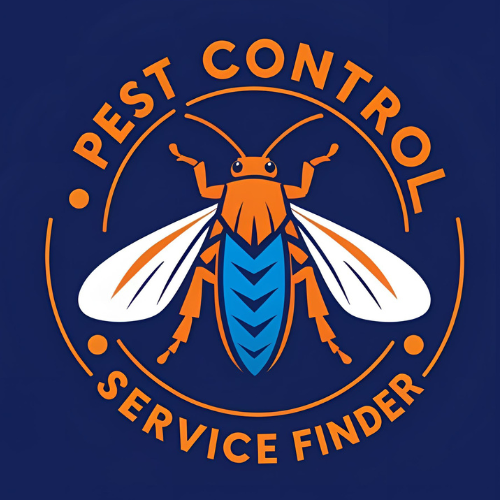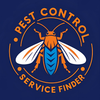What Is This Brown Bug That Looks Like a Roach?
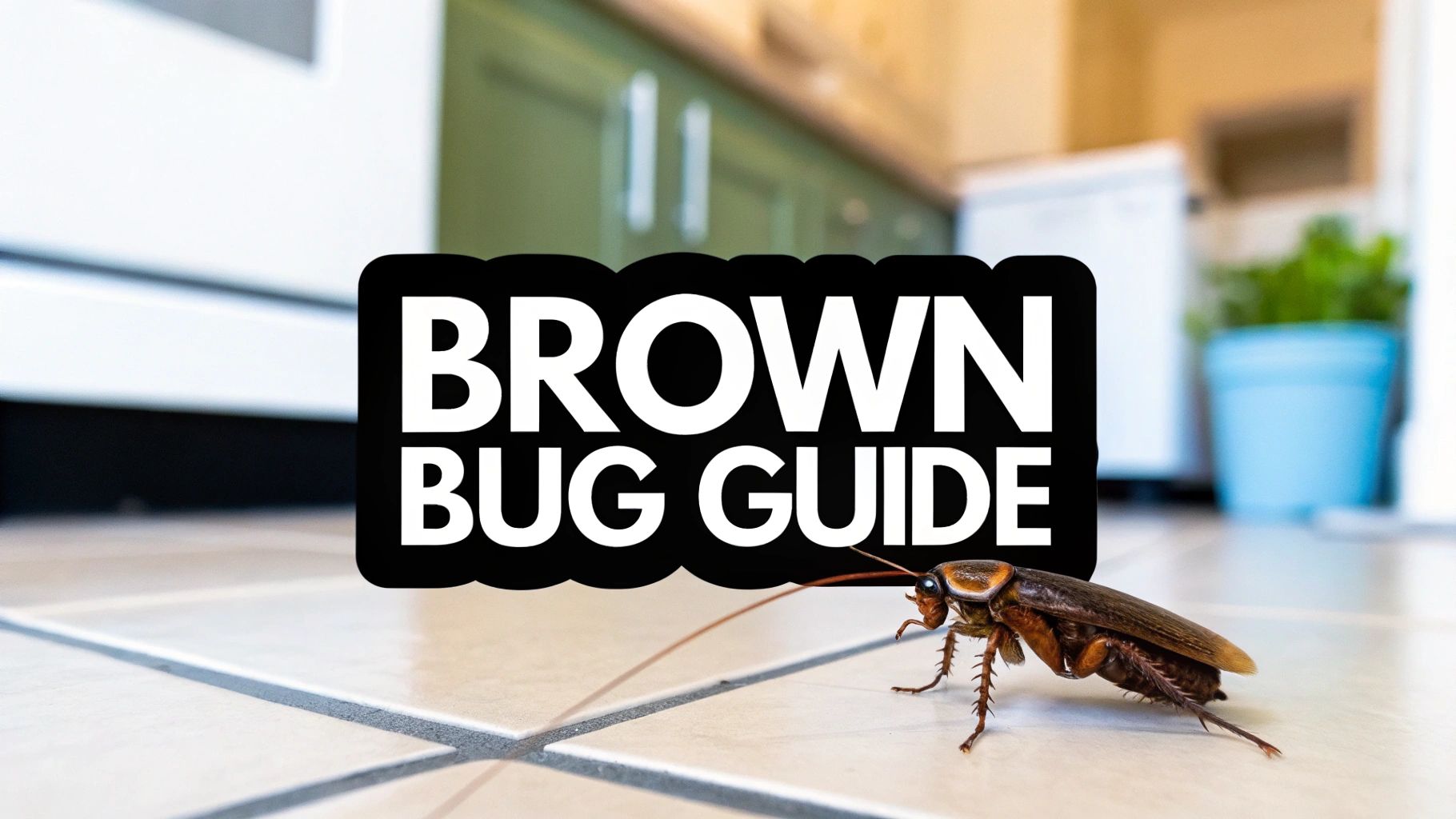
For immediate help identifying that brown bug that looks like a roach, Call +1 855 224 3071 to speak with a pest control specialist.
The most common look-alikes are certain types of beetles and crickets. You can usually tell them apart by their body shape and the length of their antennae. Cockroaches have a distinctly flat, oval body, while beetles are more rounded, and crickets have a more tube-like, cylindrical shape.
What Is This Brown Bug in Your Home?
Spotting a strange bug skittering across your floor is enough to make anyone's skin crawl. The first thought that usually pops into your head is the dreaded "C-word": cockroach.
While it's smart to be concerned, many harmless insects are often mistaken for roaches. Figuring out exactly what you're dealing with is the critical first step before deciding what to do next.
If you've found a brown bug that looks like a roach, it's likely one of a few common household intruders, and each has its own tell-tale signs. Trying to play detective on your own can be stressful, which is why a quick call can bring immediate relief. For a fast, no-nonsense identification, call +1 855 224 3071.
Key Differences Between Roaches and Look-Alikes
Let's break down the most obvious features to help you start your investigation. Think of yourself as a crime scene investigator, looking for clues to unmask the culprit. The three biggest giveaways are body shape, antennae length, and how the bug moves.
A cockroach’s body is broad and flattened, an evolutionary advantage that lets it squeeze into the tightest spaces. By comparison, many beetles have a hard, dome-shaped shell, like a tiny tank. Crickets, on the other hand, have a more cylindrical body, built for jumping, not hiding.
A Visual Guide to Bug Identification
Looking at these key features can help you make a pretty good educated guess right away. This simple visual guide walks you through the main checkpoints to identify the bug in your house.
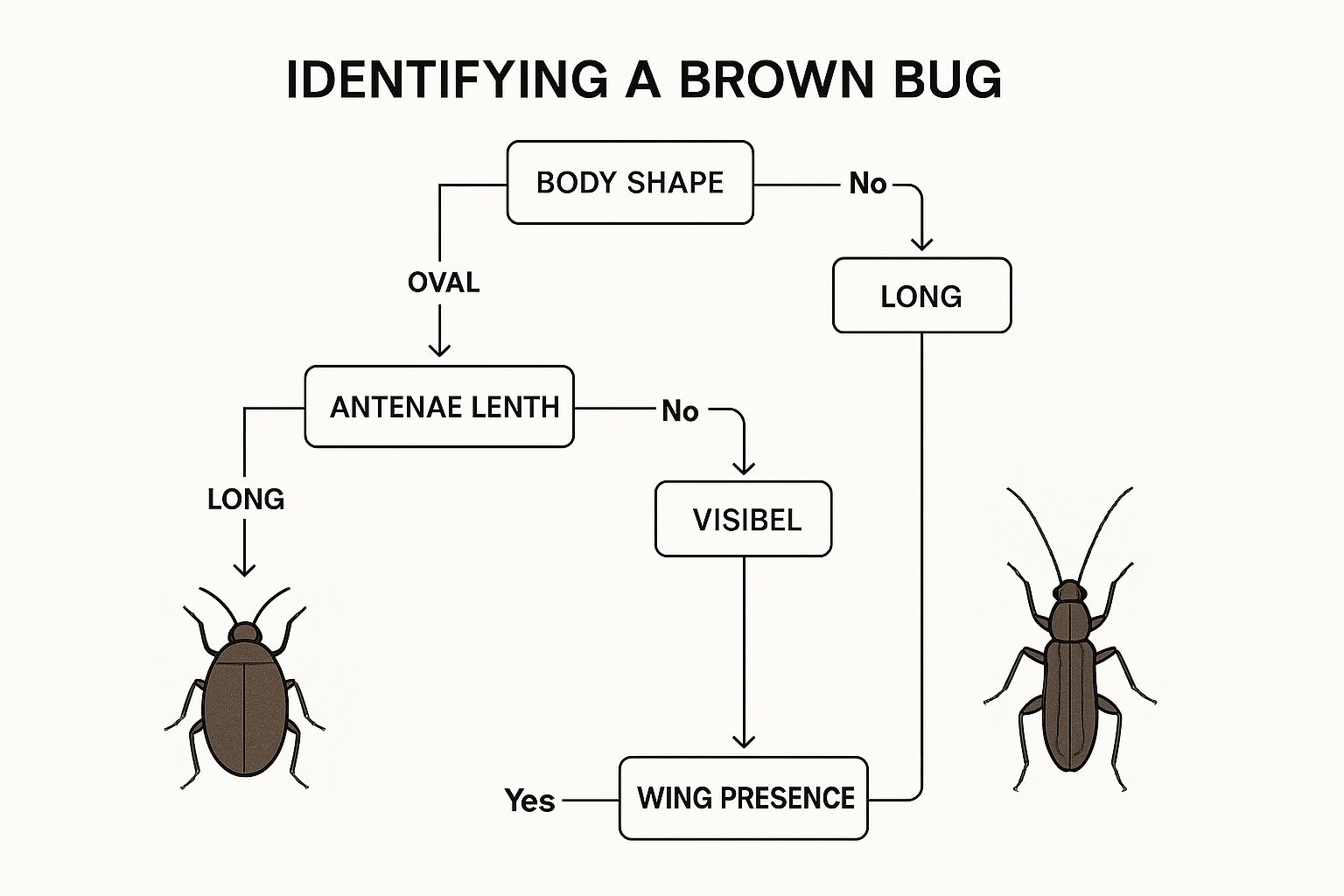
This chart helps simplify the process by zeroing in on body shape, antennae, and wings, guiding you toward the most likely suspect.
One of the most classic signs of a cockroach is its long, thread-like antennae. In contrast, beetles and crickets typically have shorter, thicker antennae.
Roach vs Look-Alike Quick Identification Guide
Sometimes, a direct side-by-side comparison is the easiest way to see the differences clearly. We've put together this quick guide to help you distinguish between a cockroach and its most common imposters at a glance.
This table highlights the main characteristics of cockroaches versus beetles and crickets.
| Feature | Cockroach | Beetle (e.g., June Bug) | Cricket |
|---|---|---|---|
| Body Shape | Flat and oval, allowing it to hide in narrow cracks. | Hard-shelled, often rounded or stout in shape. | Cylindrical and somewhat elongated. |
| Antennae | Very long, thin, and thread-like, often as long as the body. | Shorter and thicker, sometimes clubbed at the end. | Long and thin, similar to a roach but often less mobile. |
| Movement | Scurries quickly and prefers to run rather than fly. | Moves slower and more clumsily on surfaces; may fly toward lights. | Known for its distinct jumping or hopping motion when disturbed. |
Still not sure after checking the guide? The smartest and safest move is to get a professional's eyes on it. You can reach our team any time by calling +1 855 224 3071.
If you think you've spotted a brown-banded cockroach in your home, don't wait for the problem to get worse. For a professional ID and immediate help, Call +1 855 224 3071.
Meet the Brown-Banded Cockroach
When you're trying to identify a brown, roach-like bug, the brown-banded cockroach is a common culprit. But this pest plays by a different set of rules than its more infamous cousins, making it a unique challenge for homeowners.
Most cockroaches are drawn to damp, dark spots like basements or the plumbing under a sink. Not this one. The brown-banded cockroach prefers things high and dry. You could almost call it the "attic dweller" of the roach world because you're far more likely to find them in places you'd never think to look for a roach.
This love for warmth and dryness means they can show up anywhere—living rooms, bedrooms, and even inside your electronics. Because they infest the entire home, not just kitchens and bathrooms, they can be incredibly difficult to get rid of on your own. If this sounds like what you're dealing with, call +1 855 224 3071 for a proper inspection.
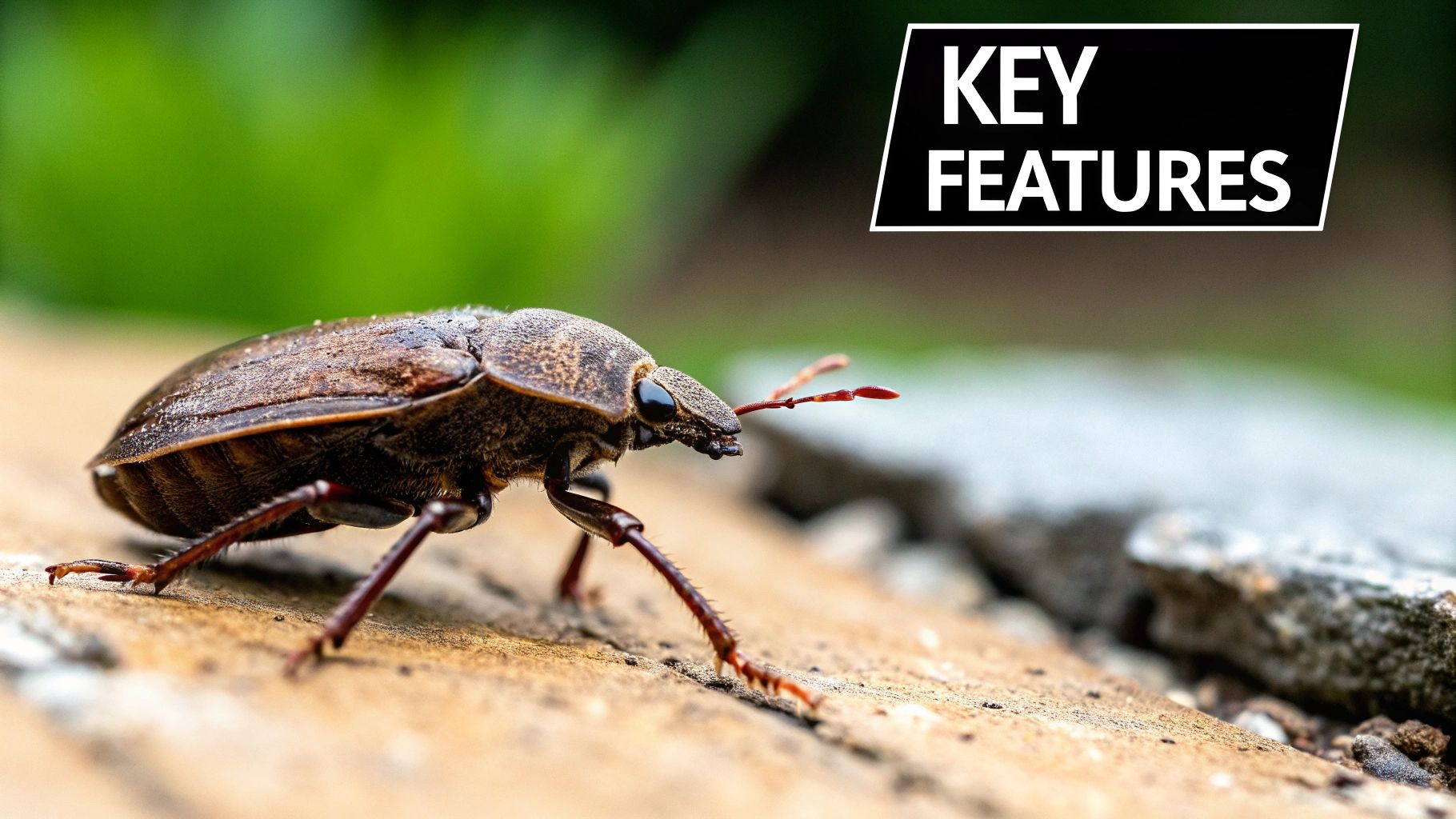
Distinctive Markings and Appearance
The biggest clue is right in the name. The brown-banded cockroach has two very obvious light-yellow or brownish bands that run across its back. These stripes are easiest to see on the young nymphs and adult females.
These markings are a dead giveaway. While other roaches are usually a solid, uniform color, these stripes make the brown-banded roach stand out.
A key thing to look for: on adult males, the wings can sometimes cover up the bands. But on the smaller, flightless females and the nymphs, those bands are crystal clear. It's a great detail to help you confirm the ID.
The brown-banded cockroach (Supella longipalpa) has been a stubborn pest in the U.S. since it first showed up in 1903. Adults are pretty small, only about 10 to 14 millimeters long. They love hiding in high, dry spots like the top shelves of kitchen cabinets, behind picture frames, or in the warm casings of TVs and clocks. You can learn more about their unique behaviors from full research on brown-banded cockroaches.
Understanding Male vs Female Behaviors
Interestingly, the males and females act very differently, which has a big impact on how an infestation spreads. Knowing these differences helps you understand what you're up against.
The males have long wings that extend past their bodies, and they can fly. If you ever see a small, brown, roach-like bug buzzing around a light, there's a good chance it's a male brown-banded cockroach.
Females, on the other hand, have short, underdeveloped wings that don't cover their whole body. They can't fly at all, so they stick to crawling and hiding. Because the males can fly, they can easily travel from room to room, spreading the infestation much faster.
Where Do Brown-Banded Roaches Hide
Since these roaches don't need a lot of moisture, their hiding places are almost limitless and often in spots you'd completely overlook. They're just looking for warmth, and modern homes offer plenty of it.
Here are some of their favorite hideouts:
- In and Around Electronics: The heat from TVs, computers, stereos, and kitchen appliances creates the perfect cozy home for them.
- High on Walls and Ceilings: Check behind picture frames, wall clocks, and in the gaps of drop ceilings.
- Inside Furniture: They love hiding on the underside of tables and chairs, or inside drawers and cabinets that you don't use very often.
- Closets and Pantries: The top shelves, where things are stored and left alone, are prime nesting spots.
Finding these pests in so many different places can be unsettling. Their ability to live anywhere in your house is exactly why a professional treatment plan is so crucial. For a complete home evaluation, your best bet is to call +1 855 224 3071 and talk to an expert.
Not sure which type of roach you're dealing with? For a definitive identification and effective treatment plan, Call +1 855 224 3071 to speak with a pest control specialist immediately.
Identifying Other Common Cockroach Species
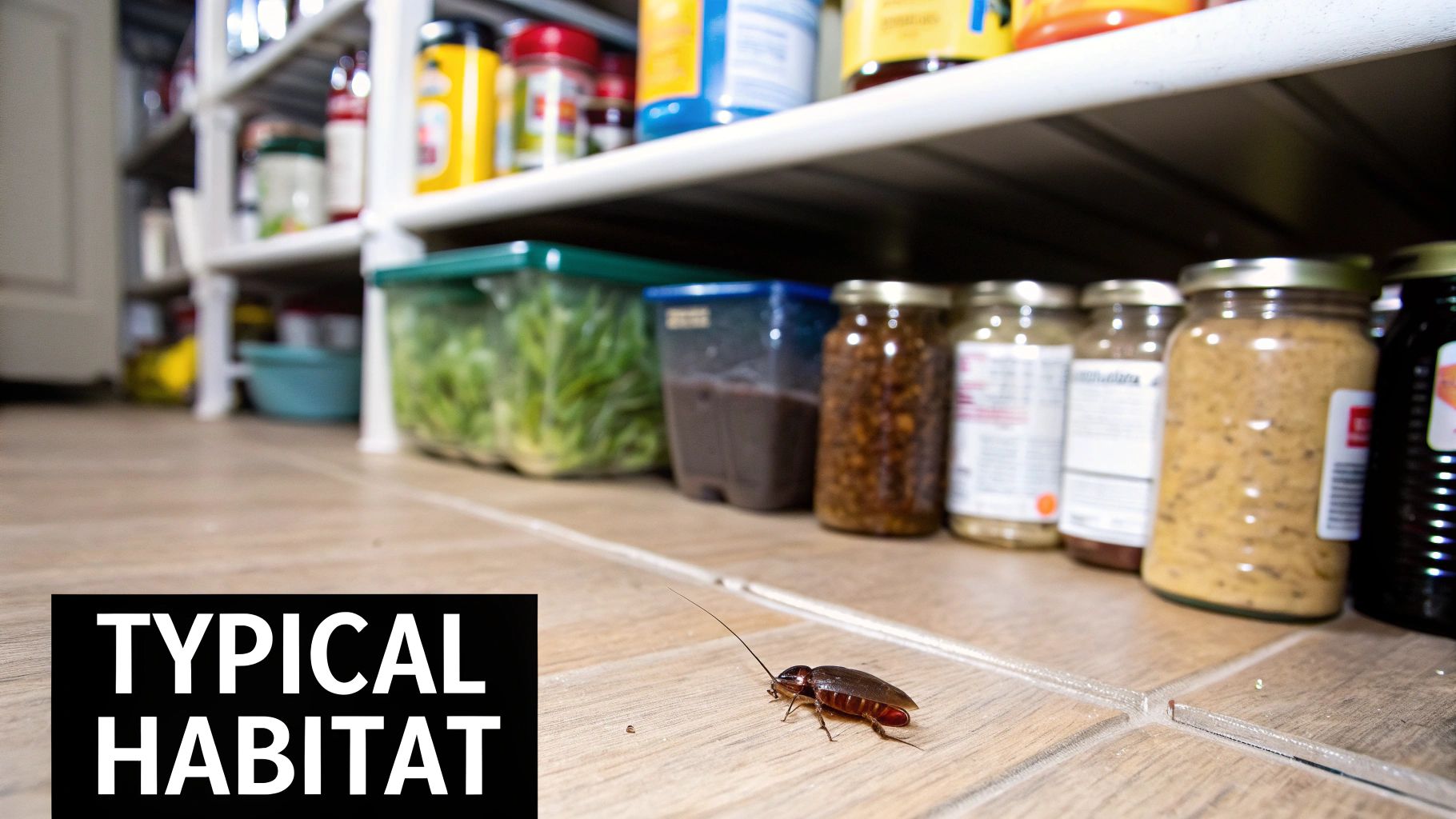
While the brown-banded cockroach is a strong suspect for that mystery brown bug that looks like a roach, it's certainly not the only one. Two other usual suspects often invade homes: the German cockroach and the American cockroach.
Each one has its own look, habits, and preferences, which is why figuring out exactly what you're dealing with is so important. Think of it like a doctor needing the right diagnosis before prescribing medicine. If you misidentify the roach, you'll use the wrong tactics, wasting time and letting the infestation get worse.
If you’re struggling to tell these pests apart, a professional eye can make all the difference. Get a clear answer and expert advice by calling +1 855 224 3071 today.
The German Cockroach: A Moisture-Loving Invader
The German cockroach is probably the most infamous indoor pest on the planet. If you spot a roach in your kitchen or bathroom, there's a good chance it's this one. They're on the smaller side, usually about half an inch long, with a light brown or tan body.
Their dead giveaway? Two dark, parallel stripes running down their back, just behind the head. Unlike their brown-banded cousins who like it dry, German roaches are all about warmth, moisture, and easy access to food.
This makes kitchens and bathrooms prime real estate for them—think behind the fridge, under the sink, or deep inside cabinets. Seeing them is a huge red flag that you have a sanitation or moisture problem to fix.
The American Cockroach: The Largest Offender
On the other end of the spectrum, you have the American cockroach. These are the giants of the common house-infesting roach world, capable of growing over two inches long. Their reddish-brown color and a unique yellowish figure-eight pattern behind their head make them pretty easy to spot.
American roaches thrive in warm, damp places. You'll typically find them in basements, boiler rooms, sewers, and lurking around pipes. While they might wander into your kitchen for a snack, they'd much rather hang out in the less-disturbed, humid parts of your home.
A key thing to know about American cockroaches is that they are skilled fliers. They're often drawn to lights at night, which is how they sometimes find their way inside through an open window or a gap under the door.
Worldwide, there are over 3,500 species of cockroaches, but thankfully only a few are common pests in the U.S. The German cockroach is the most common indoor species globally, but the brown-banded roach is right up there. It’s a bit smaller than the German, measuring about 10 to 14 mm, and gets its name from two very obvious light-colored bands across its back. You can dig into more cockroach species facts on extension.umd.edu.
Why Species Identification Matters for Treatment
Knowing which roach you have changes everything about how you fight back. Baits that work wonders on German roaches might be completely ignored by American roaches, who forage for food differently. Likewise, putting traps under the sink is pointless if you have brown-banded roaches, since they prefer to hide up high in dry spots.
- German Cockroaches: Treatment needs to be focused on kitchens and bathrooms. The best approach combines baits with insect growth regulators to stop their incredibly fast breeding cycle.
- American Cockroaches: Control often starts on the outside. Treating the perimeter of your home, basement, and crawl spaces creates a barrier and cuts off their moisture sources.
- Brown-Banded Cockroaches: You need a whole-house strategy for these guys. That means inspecting everything from furniture and electronics to the tops of cabinets and high shelves.
Trying to fight an infestation without knowing your enemy is a recipe for frustration. For more tips, check out our guide on how to get rid of roaches once you know what you're up against.
For a guaranteed solution that’s specifically designed for the roach in your home, Call +1 855 224 3071 and let a professional take over.
If you think that brown, roach-like bug is actually a cockroach, you need to act fast to keep your family safe. For immediate help understanding the risks and what to do next, Call +1 855 224 3071.
Understanding the Health Risks of Cockroaches
Spotting a cockroach skittering across your floor is more than just a gross moment—it's a clear warning sign for your family's health. These pests are notorious for carrying invisible threats, turning your home into a potential hotbed for diseases and allergens.
The real problem isn't just the live roaches you see. The bigger danger is what they leave behind. As they crawl through your home, they drag filth everywhere, leaving a trail of saliva, feces, and shed body parts that can contaminate your countertops, your food, and even the air you breathe.
This is a serious issue because seeing one roach almost always means there's a much larger infestation hiding out of sight. For every one you spot, there could be dozens, even hundreds, lurking inside your walls, under sinks, or behind appliances. Don't wait for a full-blown invasion. Call +1 855 224 3071 to get a handle on the problem now.
Allergies and Asthma Triggers
One of the biggest health problems roaches cause is their ability to trigger nasty allergic reactions and asthma attacks. The allergens are proteins found in their saliva, droppings, and the skins they shed as they grow.
These tiny particles float into the air, get inhaled, and can cause a miserable reaction in anyone who is sensitive. In fact, studies show that cockroach allergens are a leading cause of year-round allergies and a major trigger for asthma attacks, especially for children living in cities.
According to the Asthma and Allergy Foundation of America, cockroach allergy is a huge problem. Sensitivity rates can be as high as 60% in some urban areas, making them one of the most significant indoor asthma triggers out there.
Disease Transmission and Contamination
Beyond making you sneeze and wheeze, cockroaches are basically little taxis for a whole host of dangerous germs. They spend their time crawling through disgusting places like sewers, garbage bins, and drains, picking up bacteria all over their legs and bodies.
When they march into your home, they spread those germs onto everything they touch. We’re talking kitchen counters, cutting boards, silverware, and any food left uncovered. It's a direct route for spreading disease right where you live and eat.
Here are just a few of the nasty pathogens they're known to carry:
- Salmonella: A major cause of food poisoning that brings on fever, diarrhea, and stomach cramps.
- E. coli: Can lead to severe stomach pain, bloody diarrhea, and vomiting.
- Staphylococcus and Streptococcus: These bacteria are behind everything from skin infections to much more serious illnesses.
- Poliomyelitis: The virus that causes polio. While it's much rarer today thanks to vaccines, roaches can still carry it.
Getting rid of these pests for good takes more than just a can of bug spray. While you might get some ideas from a guide on a home remedy roach killer, a serious infestation poses health risks that demand professional help. Protecting your home is the top priority. If you're worried about contamination, the smartest move is to Call +1 855 224 3071 for a professional inspection and treatment plan.
If you need a professional home inspection or a custom prevention plan, call our experts at +1 855 224 3071. When it comes to dealing with a brown bug that looks like a roach, the absolute best strategy is making sure it never wants to move in. Prevention is always easier—and a lot less stressful—than fighting off an infestation that’s already taken hold.
Think of it as creating a first line of defense. By making your home as unappealing as possible to pests, you're building a powerful barrier. This all comes down to a simple but consistent focus on three key areas: sanitation, home maintenance, and smart food storage. Nailing these habits can dramatically lower the odds of ever having a pest problem.
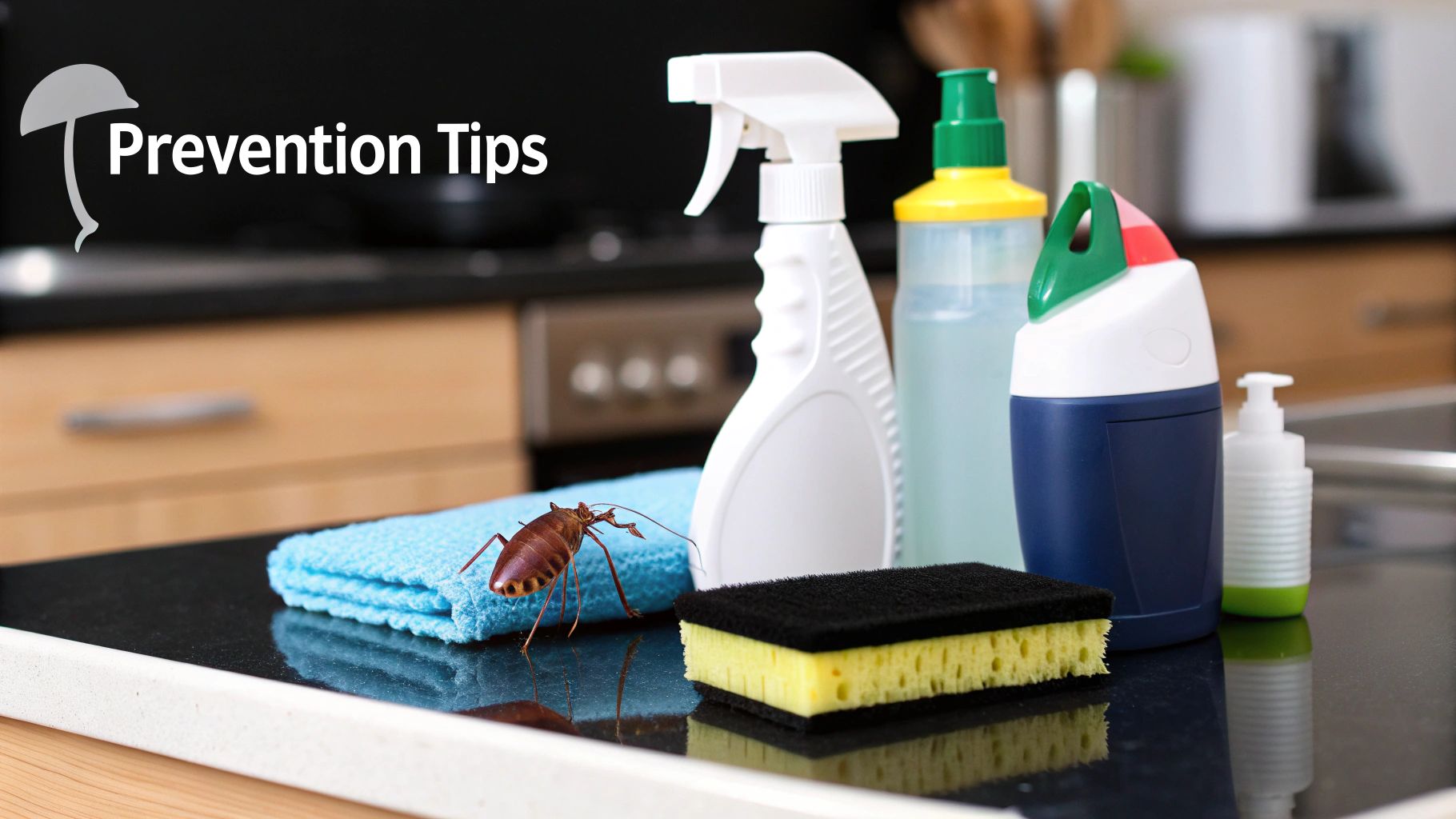
Fortify Your Home Against Invaders
Pests are absolute masters at finding their way inside through the tiniest, most overlooked entry points. Your house is like a castle—even a small crack in the wall can be an open invitation for an entire army of invaders. Sealing these gaps is one of the most effective things you can do.
Start by walking around the outside and inside of your home. Look for cracks in the foundation, gaps around door and window frames, and any openings where pipes or utility lines come through the walls. Grab some caulk for the small cracks and steel wool for larger holes to block off these pest highways.
A cockroach can squeeze through a crack as thin as a dime. This incredible ability means that even seemingly insignificant gaps can serve as an open invitation for a full-scale infestation.
Don't forget to check the screens on your windows and doors for any rips or tears. A damaged screen is basically a welcome mat for flying pests, which includes the males of certain roach species. If you're not sure where to look, call +1 855 224 3071 for a professional assessment.
Eliminate Food and Water Sources
Roaches and other pests only need three things to thrive: food, water, and a place to hide. Take away their food and water, and your home suddenly becomes a desert they can't survive in. This is where your daily cleaning and storage habits make all the difference.
Simple things you do every day have a huge impact. Wipe down your counters after every meal, sweep or vacuum the floors to get rid of crumbs, and never, ever leave dirty dishes in the sink overnight. A clean kitchen is a pest-free kitchen.
Here are a few essential tips to cut off their supplies:
- Airtight Food Storage: Move pantry items like cereal, flour, and sugar into sealed glass or plastic containers. Pests can chew right through cardboard boxes.
- Mind the Pet Food: Don't leave pet food sitting out all night. Seal it up in a container and make sure to wash the bowls regularly.
- Secure Your Trash: Always use trash cans with lids that fit tightly, and take the garbage out often. It’s also a good idea to wash out the bins themselves to remove any sticky residue.
Fixing leaks is just as crucial. That dripping faucet or leaky pipe under the sink is a five-star resort for thirsty pests. For more great ideas, check out this guide on how to keep roaches away with some simple, effective strategies.
Reduce Clutter and Hiding Spots
Pests absolutely love clutter. Why? It gives them countless dark, undisturbed places to hide, live, and multiply. Stacks of cardboard boxes, old newspapers, and piles of laundry are prime real estate for a brown bug that looks like a roach.
By decluttering your home—especially in storage spots like the basement, attic, and garage—you're getting rid of their safe houses. Keep these areas organized and, whenever possible, store your belongings in plastic bins instead of cardboard. When you minimize the clutter, you give pests fewer places to hide, making your home a far less attractive place to settle down.
If you’ve done all this and you're still seeing pests, don't wait. Call +1 855 224 3071 right away.
To help you get started, we've put together a simple checklist that covers the most important prevention steps.
Home Pest Prevention Checklist
Following these actionable steps can significantly reduce the risk of a pest problem and help you maintain a clean, pest-free environment.
| Area of Focus | Action Item | Why It's Important |
|---|---|---|
| Home Exterior | Seal cracks in foundation, siding, and around windows. | Eliminates entry points for insects and rodents. |
| Kitchen Sanitation | Wipe down counters daily and sweep for crumbs. | Removes the primary food source for pests like roaches and ants. |
| Food Storage | Store pantry items in airtight plastic or glass containers. | Prevents pests from accessing and contaminating your food. |
| Water Sources | Fix leaky faucets and pipes promptly. | Cuts off the essential water supply that pests need to survive. |
| Trash Management | Use trash cans with tight-fitting lids and empty them often. | Reduces odors and access to food scraps that attract pests. |
| Clutter Control | Organize basements, attics, and garages; use plastic bins. | Removes hiding and breeding grounds for pests. |
| Windows & Doors | Repair or replace any torn screens. | Blocks flying insects and other crawlers from getting inside. |
| Pet Areas | Store pet food in sealed containers and clean bowls daily. | Pet food is a major attractant for roaches, ants, and rodents. |
By making this checklist a regular part of your home maintenance routine, you create a powerful and lasting defense against common household pests.
Knowing When to Call a Pest Control Professional
If you’re on the fence about whether your pest problem is serious enough for a pro, that’s your first sign. For a fast, definitive answer and immediate peace of mind, Call +1 855 224 3071. While a single, stray bug can sometimes be handled with DIY methods, a true infestation calls for a much more serious response.
Trying to fight a persistent pest problem on your own often feels like a frustrating, losing battle. Those store-bought sprays and traps might offer a temporary sense of victory, but they almost never get to the root of the issue—the hidden nests. A brown bug that looks like a roach is usually just the scout for a much larger, unseen colony thriving inside your walls, attic, or crawl spaces.
Many homeowners lose weeks, or even months, cycling through different DIY products, only to watch the problem get worse. This delay is exactly what the pests need to grow their numbers exponentially. A single female cockroach can lay hundreds of eggs in her lifetime, turning a minor inconvenience into a major crisis faster than you'd think.
Signs Your DIY Efforts Are Failing
It’s critical to know when to throw in the towel. If you start noticing any of these signs, it's a clear signal that the infestation has outgrown a simple DIY fix. Continuing to self-treat at this point is like putting a bandage on a broken leg—it’s not just ineffective, it allows the problem to get much, much worse.
Here are the red flags that demand professional help:
- Seeing Roaches During the Day: Cockroaches are nocturnal. If you're spotting them in broad daylight, it’s a bad sign. It often means their hiding spots are so overcrowded they're being forced out into the open to search for food.
- Finding Droppings or Smear Marks: Tiny, dark specks that look like coffee grounds or black pepper are a classic sign of a roach problem. You’ll usually find them in cabinets, behind appliances, or along baseboards.
- Discovering Egg Casings: Finding empty, light-brown egg casings (called oothecae) is the smoking gun. It’s definitive proof that roaches aren’t just visiting—they’re actively breeding in your home.
The Dangers of Ineffective Treatment
Grabbing an aerosol spray from the store might feel proactive, but these products have major downsides. They typically only kill the bugs you see, leaving the hidden nest—the source of the problem—completely untouched. Worse yet, improper use can expose your family and pets to chemicals they don’t need to be around.
Professional pest control isn't just about killing bugs; it's about doing it safely and completely. A trained technician uses targeted treatments that are powerful enough to wipe out the entire colony but are applied in a way that’s safe for your family and pets.
A professional exterminator does far more than just spray. They start with a thorough inspection to identify the exact species, find where they're getting in, and locate their nesting sites. From there, they build a customized treatment plan that actually solves the problem for good.
Don’t wait for a small pest issue to become a nightmare. For a complete solution that protects your home and family, Call +1 855 224 3071 for a professional inspection and a plan to get your home back.
Need answers now? Don't wait. Call +1 855 224 3071 for immediate help identifying your pest and getting a fast solution.
Your Questions Answered
Finding a mysterious brown bug that looks like a roach can send anyone into a panic. Here are the answers to the questions we hear most often from homeowners who've just found an unwelcome guest.
Are Brown Bugs That Look Like Roaches Always a Bad Sign?
Not always, but you should absolutely treat it like one until you know for sure. It’s true that plenty of harmless bugs get mistaken for roaches—certain beetles or even crickets can look similar at a glance.
The trick is to notice the details. Roaches almost always have long, thread-like antennae and flat, oval-shaped bodies. Beetles, on the other hand, tend to be more rounded with short, clubbed antennae.
But here’s the bottom line: a real roach is a sign of a much larger, hidden infestation. If you have any doubt, don't risk it. It’s always safer to get a professional to take a look.
Why Am I Seeing Roaches in Clean Areas of My Home?
This is one of the most frustrating things a homeowner can experience. You keep a spotless house, yet you find a roach in a pristine bedroom or living room. This usually points to a specific culprit: the brown-banded cockroach.
Unlike German cockroaches that stick to the moisture in kitchens and bathrooms, these guys love warm, dry spots. That means they’ll happily set up shop behind your picture frames, inside electronics, or on the top shelf of a closet. Their presence has less to do with dirt and more to do with finding a quiet, undisturbed place to live.
If you’re seeing bugs far from the kitchen, call +1 855 224 3071. You need a plan that covers your whole home.
A roach problem is not a sign that your home is dirty. Pests can squeeze through the tiniest cracks or hitch a ride on deliveries. Once they're inside, they can thrive no matter how much you clean.
Can I Get Rid of Roaches on My Own?
If you see a single bug that wandered in from outside, a DIY approach might be enough. But if you're dealing with a true infestation, those store-bought sprays and traps just won't cut it.
Here’s why: they only kill the few roaches you see scuttling across the floor. They do nothing to the hidden nest, where hundreds or thousands more are breeding. Roaches are tough and multiply incredibly fast, so what seems like a small problem today can become a full-blown invasion in a matter of weeks.
Professional treatments are designed to wipe out the entire colony at the source. It's the only way to get a lasting solution. Don't let a minor issue spiral out of control—get an expert on the line by calling +1 855 224 3071.
For a definitive solution and real peace of mind, it’s time to call in the professionals. Pest Control Service Finder connects you with local, vetted exterminators who are ready to tackle any pest problem, big or small. Visit https://pestcontrol-service-finder.com to get a no-obligation quote and fast, same-day service.
